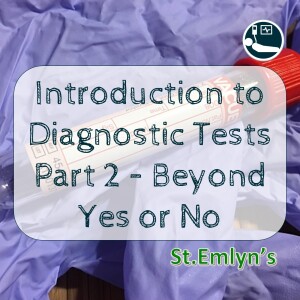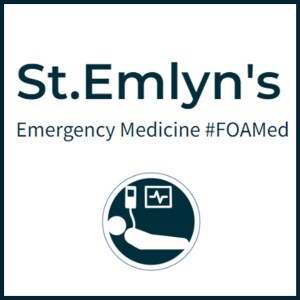
Ep 4 - Understanding diagnostics In Emergency Medicine Part 2 - Beyond Yes or No
 2014-06-15
2014-06-15
A diagnosis is essentially a label that we put on a patient to indicate what they have, which then guides our treatment decisions. In the ED, our primary focus is on identifying life-threatening conditions. This approach often involves working backwards by first ruling out serious conditions before considering what a patient might actually have.
Initial Diagnostic Approach
As emergency physicians, our initial approach is to use tests with high sensitivity. These tests are designed to pick up anyone who might have the disease. Once we rule out the serious conditions, we look at tests with high specificity to confirm the diagnosis, as treatments often carry risks. For example, therapies such as thrombolysis come with significant risks, so we need to be fairly certain before proceeding, unlike less consequential treatments like wrist splints.
Understanding Probabilities in Diagnoses
When we say a patient has a diagnosis, we’re essentially saying it’s likely enough to treat. Conversely, when we say a patient doesn’t have a diagnosis, we mean it’s unlikely enough to withhold treatment. This probabilistic approach is vital in the ED and can be surprising to many people.
Case Study: Cardiac Chest Pain
Let’s apply this to a patient with cardiac-sounding chest pain. Our goal is to either rule out or confirm the disease and start appropriate treatment. We start with specific tests to rule in a diagnosis, such as an ECG. A positive ECG with significant ST segment changes indicates a high likelihood of disease, warranting immediate treatment. This approach quickly sorts out high-risk patients.
For patients with normal or near-normal ECGs but still concerning symptoms, we need sensitive tests to ensure we don't miss anyone with myocardial disease. About 10% of these patients might have underlying issues, so we need to ensure our tests are sensitive enough to catch these cases.
Using Prevalence and Pre-test Probability
To decide if a patient has the disease, we must consider the prevalence or pre-test probability in our population. For example, in patients with normal ECGs and no alarming history, the pre-test probability might be around 10%. This isn’t low enough to rule out the disease but also not high enough to justify treatment without further testing.
Diagnostic Processes in the ED
We use a step-by-step diagnostic process. Starting with the most specific tests to rule in a diagnosis, we then use sensitive tests like high-sensitivity troponin to rule out diseases. High-sensitivity troponin tests are great for ruling out diseases due to their sensitivity. If the test is negative, we can be confident the patient doesn’t have myocardial damage. If the test is positive but not dramatically high, we may need additional tests to confirm the diagnosis.
Each diagnostic step adjusts our patient’s probability of having the disease. Our goal is to reach a probability low enough to safely rule out the disease or high enough to justify treatment. This process is continuous, and we apply it to every patient, whether they have chest pain or another symptom like a headache.
Understanding Likelihood Ratios
We often use likelihood ratios to interpret diagnostic tests. A positive likelihood ratio increases the probability of the disease, while a negative likelihood ratio decreases it. For example, a high-sensitivity troponin test is excellent at ruling out myocardial infarction because of its high sensitivity, though it’s not as good at ruling in due to lower specificity.
Optimising Diagnostic Tests
Diagnostic tests like troponin can be optimized by adjusting the threshold levels. For instance, a higher threshold might improve specificity and thus be better at ruling in the disease, while a lower threshold improves sensitivity, making it better at ruling out the disease. This principle applies to various tests, including white cell counts and amylase levels.
Continuous Assessment and Reassessment
In the ED, we continuously assess and reassess patients. Each diagnostic step, whether it’s asking a question about symptoms or ordering a lab test, adjusts our understanding of the patient’s condition. This iterative process helps us make informed decisions about treatment and ensures that we don’t miss critical diagnoses.
Applying the Approach to Different Symptoms
This diagnostic approach isn’t limited to chest pain. Whether a patient presents with a headache, abdominal pain, or any other symptom, we apply the same principles of sensitivity, specificity, and likelihood ratios. Each question we ask and each test we perform helps refine our assessment and move closer to a definitive diagnosis.
Conclusion
Mastering diagnostic skills in the ED involves understanding and applying probabilities, using specific and sensitive tests effectively, and continuously reassessing the patient’s condition. By focusing on these principles, we can make more accurate diagnoses, provide appropriate treatments, and ultimately improve patient outcomes.
More listening about diagnosisPodcast – Diagnosis in Emergency Medicine Part 1 – SpIN and SnOUT
Podcast – Diagnosis in Emergency Medicine Part 2 – Beyond a simple yes or no
Podcast – Diagnosis in Emergency Medicine Part 3 – The importance of prevalence
More Episodes
 2021-05-06
2021-05-06
 3.6k
3.6k
 2021-04-11
2021-04-11
 3.6k
3.6k
 2021-03-15
2021-03-15
 3.9k
3.9k
 2021-02-20
2021-02-20
 4.3k
4.3k
 2021-01-17
2021-01-17
 6.2k
6.2k
 2020-12-17
2020-12-17
 3.8k
3.8k
 2020-11-06
2020-11-06
 4.1k
4.1k
 2020-10-24
2020-10-24
 4.4k
4.4k
 2020-10-20
2020-10-20
 3.8k
3.8k
 2020-09-10
2020-09-10
 4.0k
4.0k
 2020-08-01
2020-08-01
 4.4k
4.4k
 2020-06-25
2020-06-25
 4.6k
4.6k
 2020-06-19
2020-06-19
 3.1k
3.1k
 2020-06-13
2020-06-13
 3.7k
3.7k
 2020-06-04
2020-06-04
 3.9k
3.9k
 2020-05-22
2020-05-22
 4.0k
4.0k
Create your
podcast in
minutes
- Full-featured podcast site
- Unlimited storage and bandwidth
- Comprehensive podcast stats
- Distribute to Apple Podcasts, Spotify, and more
- Make money with your podcast
It is Free
- Privacy Policy
- Cookie Policy
- Terms of Use
- Consent Preferences
- Copyright © 2015-2024 Podbean.com



